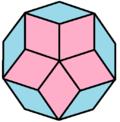Decagon prism
A regular decagon of side a = 2 cm is the base of the perpendicular prism. The side walls are squares. Find the prism volume in cm3, round to two decimal places.
Final Answer:

Tips for related online calculators
Tip: Our volume units converter will help you convert volume units.
See also our trigonometric triangle calculator.
See also our trigonometric triangle calculator.
You need to know the following knowledge to solve this word math problem:
solid geometryplanimetricsgoniometry and trigonometryUnits of physical quantitiesGrade of the word problem
Related math problems and questions:
- Prism bases
 Volume perpendicular quadrilateral prism is 360 cm³. The edges of the base and height of the prism are in the ratio 5:4:2. Find the area of the base and walls of the prism.
Volume perpendicular quadrilateral prism is 360 cm³. The edges of the base and height of the prism are in the ratio 5:4:2. Find the area of the base and walls of the prism. - And-or probabilities
 P(A ) = 0.53, P(B) = 0.15, and P(A n B ) = 0.18. Find P(A U B ). Round approximations to two decimal places.
P(A ) = 0.53, P(B) = 0.15, and P(A n B ) = 0.18. Find P(A U B ). Round approximations to two decimal places. - Hexagonal prism
 The prism's base is a regular hexagon consisting of six triangles with side a = 12 cm and height va = 10.4 cm. The prism height is 5 cm. Find the volume and surface of the prism.
The prism's base is a regular hexagon consisting of six triangles with side a = 12 cm and height va = 10.4 cm. The prism height is 5 cm. Find the volume and surface of the prism. - Perpendicular 35183
 Calculate the surface and volume of a vertical prism if its height h = 18 cm and if the base is an equilateral triangle with side length a = 7.5 cm.
Calculate the surface and volume of a vertical prism if its height h = 18 cm and if the base is an equilateral triangle with side length a = 7.5 cm. - Triangular pyramid
 A perpendicular regular triangular pyramid is given: base side a = 5 cm, height v = 8 cm, volume V = 28.8 cm³. What is its area (surface area)?
A perpendicular regular triangular pyramid is given: base side a = 5 cm, height v = 8 cm, volume V = 28.8 cm³. What is its area (surface area)? - Quadrilateral pyramid
 The height of a regular quadrilateral pyramid is 6.5 cm, and the angle between the base and the side wall is 42°. Calculate the surface area and volume of the body—round calculations to 1 decimal place.
The height of a regular quadrilateral pyramid is 6.5 cm, and the angle between the base and the side wall is 42°. Calculate the surface area and volume of the body—round calculations to 1 decimal place. - Calculating 63344
 Calculate the volume of the cone formed by rotating an isosceles triangle about the height of the base. The triangle has a side length of 15 cm and a height to the base of 12 cm. When calculating, use the value pi = 3.14 and round the result to one decima
Calculate the volume of the cone formed by rotating an isosceles triangle about the height of the base. The triangle has a side length of 15 cm and a height to the base of 12 cm. When calculating, use the value pi = 3.14 and round the result to one decima
